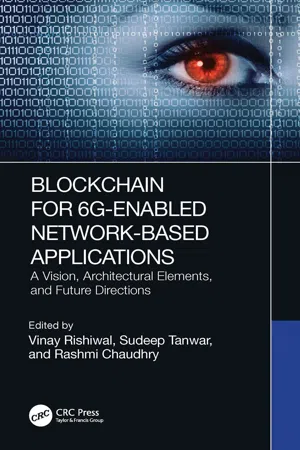
Blockchain for 6G-Enabled Network-Based Applications
A Vision, Architectural Elements, and Future Directions
Vinay Rishiwal, Sudeep Tanwar, Rashmi Chaudhry, Vinay Rishiwal, Sudeep Tanwar, Rashmi Chaudhry
- 266 pages
- English
- ePUB (adapté aux mobiles)
- Disponible sur iOS et Android
Blockchain for 6G-Enabled Network-Based Applications
A Vision, Architectural Elements, and Future Directions
Vinay Rishiwal, Sudeep Tanwar, Rashmi Chaudhry, Vinay Rishiwal, Sudeep Tanwar, Rashmi Chaudhry
À propos de ce livre
This book provides a comprehensive overview of blockchain for 6G-enabled network-based applications. Following the key services of blockchain technology, this book will be instrumental to ideate and understand the necessities, challenges, and various case studies of different 6G-based applications. The emphasis is on understanding the contributions of blockchain technology in 6G-enabled applications, and its aim is to give insights into evolution, research directions, challenges, and the ways to empower 6G applications through blockchain.
- The book consistently emphasizes the missing connection between blockchain and 6G-enabled network applications. The entire ecosystem between these two futuristic technologies is explained in a comprehensive manner.
-
- The book constitutes a one-stop guide to students, researchers, and industry professionals.
-
- The book progresses from a general introduction toward more technical aspects while remaining easy to understand throughout.
-
- Comprehensive elaboration of material is supplemented with examples and diagrams, followed by easily understandable approaches with regard to technical information given thereon.
-
Blockchain and its applications in 6G-enabled applications can drive many powerful solutions to real-world technical, scientific, and social problems. This book presents the most recent and exciting advances in blockchain for 6G-enabled network applications. Overall, this book is a complete outlet and is designed exclusively for professionals, scientists, technologists, developers, designers, and researchers in network technologies around blockchain integration with IoT, blockchain technology, information technology, and 6G-enabled industrial applications. Secondary readers include professionals involved in policy making and administration, security of public data and law, network policy developers, blockchain technology experts, regulators, and decision makers in government administrations.
Foire aux questions
Informations
Chapter 1Evolution and Innovation of Blockchain Paradigms for the 6G Ecosystem
CONTENTS
1.1 Introduction
1.1.1 Generations before 6G
| Features | 1G | 2G | 3G | 4G | 5G | 6G |
|---|---|---|---|---|---|---|
| Start | 1970– 1984 | 1980– 1999 | 1990– 2002 | 2000–010 | 2010– 2015 | 2019 |
| Technology | AMPS, NMT, TACS | GSM | WCDMA | LTE, WiMAX | MIMO, millimeter waves | GPS |
| Frequency | 30 kHz | 1.8 GHz | 1.6–2 GHz | 2–8 GHz | 3–30 GHz | 95 GHz–3 THz |
| Access system | FDMA | TDMA/CDMA | CDMA | CDMA | OFDM/BDMA | COMPASS |
| Core network | PSTN | PSTN | Packet networks | Internet | Internet | Internet |
| Speed | 2.4 Kbps | 64 Kbps | 2 mbps | 100 mbps | 300 mbps | 1 Tbps |
| Handoff | Horizontal | Horizontal | Horizontal | Horizontal/Vertical | Horizontal /Vertical | Horizontal/Vertical |
| Service | Mobile telephony | Digital voice, short messaging | Integrated high audio and video | Dynamic information access | Dynamic information access on variable devices | Dynamic information access on variable devices with AI capabilities |
| Switching | Circuit | Circuit for access N/W and air interface | Packet except air interface | All packets | All packets | All packets |
| Satellite integration | No | No | No | No | No | Yes |
| AI | No | No | No | No | Partially | Fully |
| E2E latency | No | No | No | 100 ms | 10 ms | 1 ms |
| Mobility support | No | No | No | Up to 350 km/h | Up to 500 km/h | Up to 1000 km/h |
| S.NO | Standards | Technological limitations in 5G | 6G challenges | Supported use-cases |
|---|---|---|---|---|
| 1 | Terahertz | High bandwidth with Small antenna | High propagation loss | Industry 4.0 |
| 2 | VLC | Unlicensed spectrum with low interference | RF uplink needed | E-health |
| 3 | Sensing and localization | Context-based control | Efficient multiplexing | Unmanned mobility |
| 4 | User-based network architecture | Distributed intelligence | Real-time process | Pervasive connectivity, e-health |